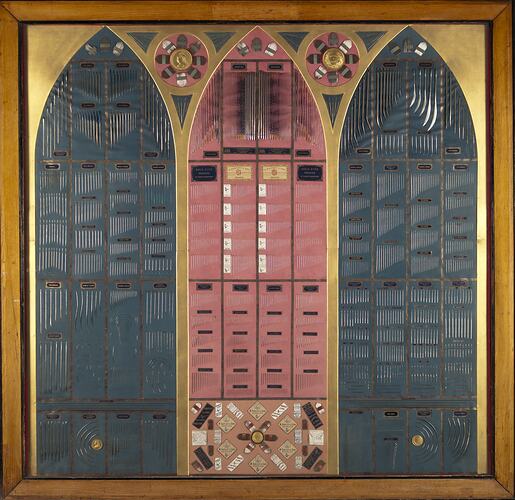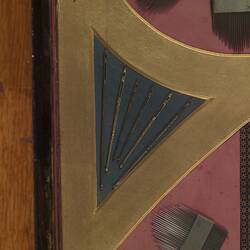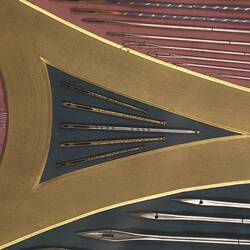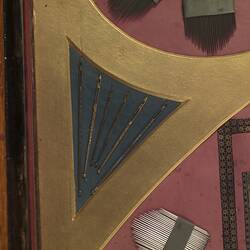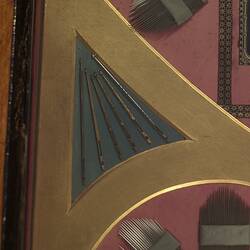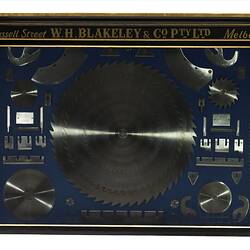Summary
A large framed exhibition piece, prepared circa 1887 within the factory of W. Bartleet & Sons, Abbey Hills, Redditch, England. Attractively displays needles, surgical needles, crochet hooks, and bodkins, etc. produced by W. Bartleet & Sons. The work, created for display at the Adelaide International Exhibition of 1887 and the Melbourne Centennial International Exhibition of 1888, shows the range of needles, crochet hooks, surgical needles, and other needles and needle cases, produced by the company.
W. Bartleet & Sons had two exhibits at the Centennial International Exhibition, 1888. The first was described 'Needles, sewing-machine needles, needle cases, crotchet hooks, fish hooks, fishing tackle', the second 'Needles and sewing machine needles' (pages 447 and 466, Centennial International Exhibition, Melbourne 1888-1889, Official Record). This piece is a very fine example of the 'typical' but now rare displays prepared by nineteenth century industrialists to promote their products. This one is finely produced, with clear design principles, and is roughly in the shape of a series of three arched windows as in a church or another ecclesiastical building. The display incorporates two medals, from the Adelaide Jubilee International Exhibition of 1887, where the Company won a First Order of Merit and three medals from the Centennial International Exhibition, where the Company won a First Order of Merit for 'Sewing and Other Machines Used for Making Up Clothing, etc.' (page 841, Centennial International Exhibition, Melbourne 1888-1889, Official Record). The needle display is framed and behind glass.
Physical Description
A large framed piece featuring a range of needles, crochet hooks, surgical needles, and other needles and needle cases. Frame is of a honey yellow oak, with a black rim with red velvet lining inside rim. Gothic window-style panels make up the piece, which is divided into three sections. Gold card frames the three panels. Left panel and right panel are backed in blue leather, while the middle panel is backed in pink leather with tan at the bottom. Pink leather also sits behind the two medals at the top of the display. Needles displayed include all types of sewing needles, surgical needles, bodkins, crochet hooks, saddlers' needles, sewing machine needles, upholsterers' needles, netting needles, sharps, bent and curved needles, etc. Needles are made from bronze, steel, and gold. Labels, in navy blue, black, and bone with gold or black letters, are used to describe the needle types displayed. Five medals won at International Exhibitions are included in the display: two from the Adelaide Jubilee International Exhibition 1887 are displayed in roundels at the top of the display, and three from the Melbourne Centennial International Exhibition 1888 are displayed below each arch at the bottom. The middle panel includes Bartleet & Sons packaging and needle cases, displaying their distinct 'Archer Brand' trade mark. Packets are labelled 'penny packet' and 'one penny'. Needles are all securely held in place by cotton string, wire or ribbon. Sewing machine needles are generally numbered.
More Information
-
Collection Names
-
Collecting Areas
-
Acquisition Information
Donation from Deakin University Museum of Art, Deakin University, Dec 2007
-
Maker
W. Bartleet & Sons, Redditch, England, Great Britain, circa 1887
-
Date Made
-
Inscriptions
Some needles are engraved with 'W. BARTLEET & SONS' and one is engraved 'PRINCESS CHARLOTTE DIED' and another underneath 'NOV 6 1817 AGED 21'.
-
Support
Leather
-
Classification
Public events, Melbourne centennial exhibition 1888, Exhibition heritage
-
Category
-
Discipline
-
Type of item
-
Overall Dimensions
1760 mm (Width), 90 mm (Depth), 1710 mm (Height)
Overall Dimensions - without strap
-
References
A high resolution image of this object appears on the Google Art Project website: [Link 1]!asset-viewer:l.id=jAGoOHF7h9Mofw&projectId=art-project&urlStub=Trade%20Needle%20Display
-
Keywords
Exhibitions: Melbourne International Centennial, 1888-1889, Needles, Needlework Equipment, Royal Exhibition Building
